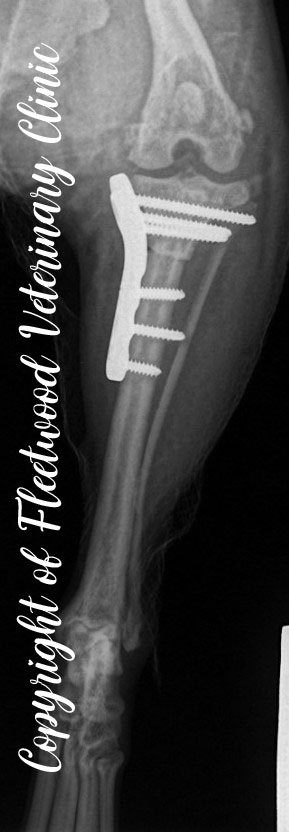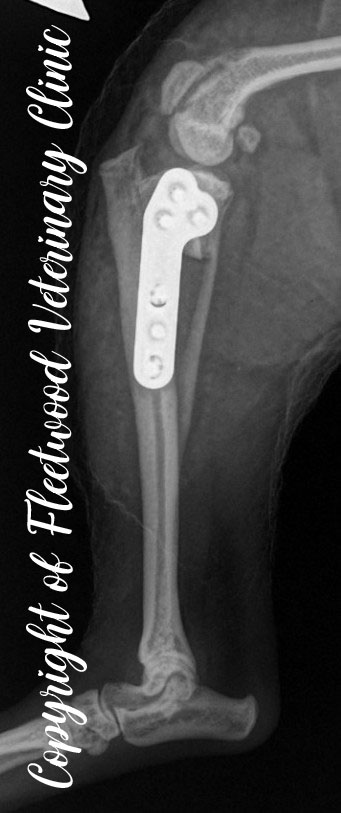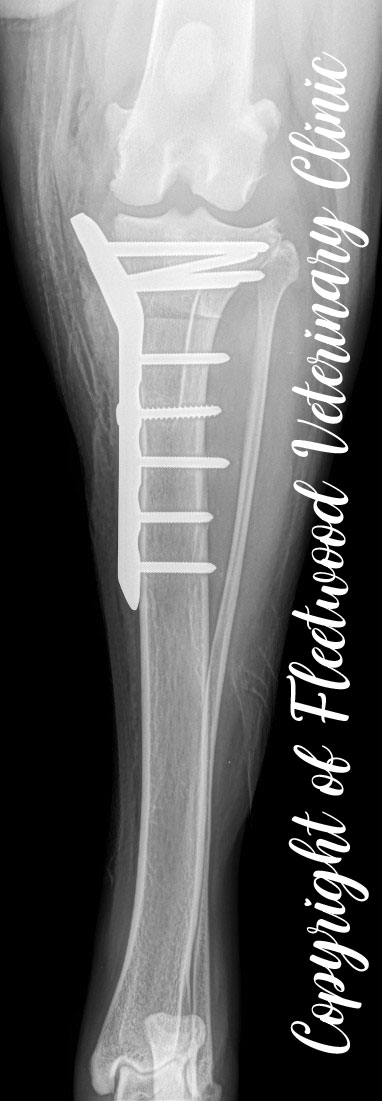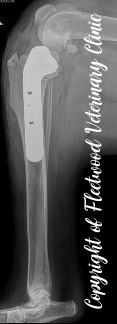|
ANATOMY
The canine knee joint, known as the stifle joint, is similar to a human’s knee in many regards. The joint is made up of the femur (thigh bone), tibia (shin bone), and the patella (kneecap) that are firmly held together by ligaments. Ligaments are strong, dense structures consisting of connective tissue that join the ends of two bones across a joint. The function of ligaments is to stabilize the joint.
The stifle has two very important ligaments called the cranial (CrCL) and caudal (CaCL) cruciate ligaments (cruciate means a cross or crucifix) that cross in the center of the joint. The CrCL (known as the ACL in humans) restrains the backward and forward motion of the joint, in addition to inward twisting and hyperextension of the joint. It is the structure that is most commonly injured in dogs. In fact, more than 600,000 dogs in the U.S. have surgery for this problem every year.
The stifle also has two half-moon shaped cartilage structures between the weight-bearing bone ends called menisci. There are two menisci in each stifle, one on the inner side of the joint called the medial meniscus and one on the outer side of the joint called the lateral meniscus. The menisci add support to the stifle and also serve as shock absorbers by spreading the weight load.
EFFECTS OF CrCL TEAR
The top of the tibia bone, called the tibial plateau is angled downward. When the CCL is torn, weight-bearing forces causes the femur bone to slide down this slope. Not only is this painful, but also causes the stifle to shift out of place during weight-bearing movement. As the femur slides down the tibial plateau, the meniscal cartilage—a cushion between the bones that acts as a shock absorber may be crushed.
In about 50% of the dogs with CrCL injuries, the meniscal cartilage has been injured as well. This type of injury is often accompanied by a “click” that can be heard when a dog walks. When the CrCL is weakened or torn, the most significant long-term change in the joint is the development of Clinical signs and diagnosis.
Most dogs with a complete CrCL tear show an immediate onset of lameness. While there may be some initial improvement over several days, there usually is a dramatic decline in limb function over time. Dogs that have a partial CrCL tear may have persistent lameness on the affected limb, yet others have stiffness or lameness on the limb after taking a nap or while exercising.
Your veterinarian may detect swelling in the knee and instability in the stifle upon examination of the joint. Dogs that have a partially torn CrCL may not have any detectable instability of the joint and x-rays of the joint may be needed to support the diagnosis arthritis.
THE DAY OF SURGERY
Our anesthesia and surgical team will prescribe a pain management program, both during and after surgery that will keep your companion comfortable. This will include a combination of general anesthesia, injectable analgesics, oral analgesics and anti-inflammatories.
TREATMENT
In small dogs, nylon bands can be used to stabilize the knee, however, this technique is not consistently effective in large breeds
The surgery that is recommended for medium and large breed dogs that have CCL tears is the tibial plateau leveling osteotomy (TPLO).
The TPLO levels the slope of the tibia by cutting the bone and rotating it . A plate is fastened onto the side of the bone with a set of screws to hold the tibia together during the healing process. The TPLO keeps the femur bone from shifting backward during weight-bearing activities and allows other supporting structures of the stifle to stabilize the joint.
HOME CARE AND RESULTS
After surgery, you can continue to give your pet a prescribed pain reliever to minimize discomfort. It’s also extremely important to limit your dog’s activity and exercise level during this post operative period. Rehabilitation exercises can be done at your home or if you choose, by professionally trained therapists at an animal rehabilitation center. Rehabilitation therapy should be continued until your dog is using the operated limb well (typically 2 - 4 weeks after surgery). The surgeon will monitor the healing process with two follow-up exams. The first is scheduled at two weeks after the surgery and the second is at eight weeks after the surgery. By 10 weeks after surgery, most dogs are fully weight-bearing on the operated limb, although exercise should be limited during the first three months after the procedure.
The TPLO procedure offer multiple benefits in comparison to older techniques which include: faster recovery, earlier use of the limb after surgery, better chance to return to athletic activity, and better range of motion of the joint. The TPLO procedure is currently the best method available for stabilizing a dog’s knee.
With good rehabilitation, 90% of dogs undergoing this surgery can expect to return to athletic activity within six months.
Click here for our TPLO Referral Form
|
|

Copyright fleetwoodvet.ca
|

Copyright fleetwoodvet.ca
|
2.5kg Yorkie TPLO & Patellar Luxation
|
.jpg)
Copyright fleetwoodvet.ca
|

Copyright fleetwoodvet.ca
|
4.5kg small dog TPLO
|

Copyright fleetwoodvet.ca
|

Copyright fleetwoodvet.ca
|
98kg dog TPLO
|
|
|
|